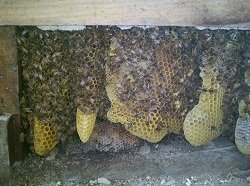How to Keep Bees
in 14 Easy Steps
How to keep bees in 14 easy steps is meant to be a beginning guide to help you remember all the details. In no time at all you will find that the How To Keep Bees List is something you do by rote and you will need no list. You will also find that you will develop your own method and style of beekeeping. As with anything beekeeping you will find if you ask 10 beekeepers [beeks] a question, you will get 10 different answers...And ALL of them correct! So, until then, here is the list:
1. Wear the correct beekeeping clothing: Amazingly enough the right clothing really does help protect your from stings. At the very least you should always wear a veil. It is not worth taking the risk of losing an eye from a sting. [Not to mention, without a veil it is easier to lose your concentration and start waving at the bees in you face. Waving at bees almost always ends up with a sting.]
Many beekeepers make an initial investment in a full suit. This can be rather expensive up front. And is not necessary for every beek. (Read our Bee Suit page to see other recommendations we have and why.)
2. Work with the bees on their schedule. The best time to check bees is on a sunny day around mid-day.Bees are usually busy gathering pollen at this time so there are fewer in the hive. That means less opportunity to agitate them. Bees does seem to feel like Bing Crosby and just love the rain. They are much more apt to sting on cloudy rainy days. So best to avoid that when possible.
3. Designate a Work tool box: For this I use a bucket. You can purchase a really cool bucket buddy at Lowes that will help you organize your tools. Having everything in one place makes it hard forget something important while you are still learning how to keep bees, it is also easy to pick up and go.
List of tools to include:
- Smoker
- a hive tool
- burning material
- matches or a lighter
- any feed or medication needed for the bees at the time you work them
- your bee keepers clothing - gloves, veil and hat
4. Get the smoker ready for use: You can use burlap, pine
needles, wood pellets, dried grass, corncobs, or mulch. When you smoke the bees they will gorge themselves on honey and be to lethargic to sting.
5. Take a folding table to the work area. Everyone has different methods of telling your how to keep bees... I use a small 4 foot table I purchased at Sam's club. It works great. I usually set the table up behind and out of the way of the guard bees. So if I need to set things on it I have a place to work.
6. Light the
smoker just before you reach the hive.
7. Approach the hive from the back, out of the landing path of the heavily laden bees. Come around to the front, and blow a few puffs of smoke into the entrance of the hive. Move away, and wait 3 minutes.
8. Open the top of the hive, and blow smoke into the inner cover. Most of the time the hive top will be glued down with propolis and you will need the hive tool to pop it off. Remove the inner cover and blow smoke between the frames as you remove and inspect them. Move slowly and patiently giving the bees plenty of time to eat.
9. Start with the frame closest to the side of the hive box: Lift out the first frame nearest the side of the box. Lay this first frame on the ground. Proceed by smoking and then removing the next respective frame and inspecting it and then moving it over to the position of the first frame. Continue until all frames have been inspected. Be gentle when lifting the frames. Slow movements will help prevent squishing any bees. You want to be very careful not to injure the queen.
10. Remove the upper box and inspect the brood box: Look for the queen and sealed brood, and make sure that you have ample frames for the colony to work with. Check on any abnormalities and pests, such as mites or moths.
11. Remove
honey-loaded hive body, and replace with a fresh super and frames. If you're
preparing the bees for winter, reduce the entrance to the hive and remove any
extra supers. This will force the bees down into the brood boxes to store honey
for the winter. If you need more information on bees and honey read our page on harvesting honey.
12. Feed and/or
medicate the bees as needed: This is one of the most important steps in learning how to keep bees. We are taking care of our bees. We need to make sure they have ample food supply.
13.Replace all hive components, and quietly leave the area.
14.Clean all
hive tools with disinfectant:
List your favorite or find a new one to try!


If you see bees going in and out of a structure, you may be in for a surprise as to what is behind the wall.